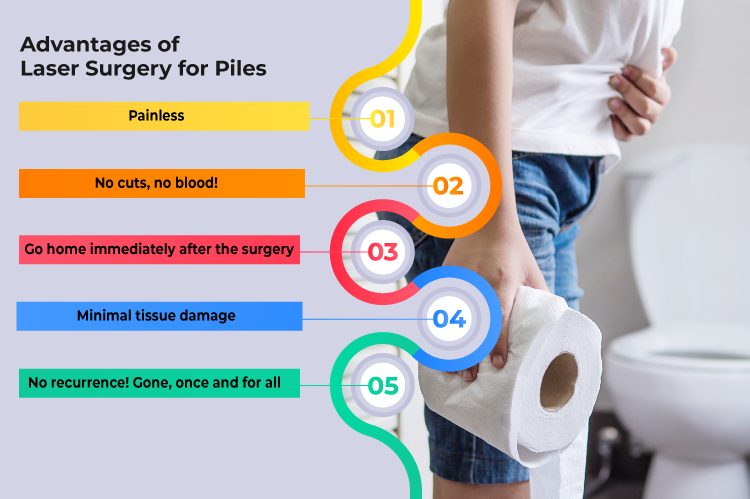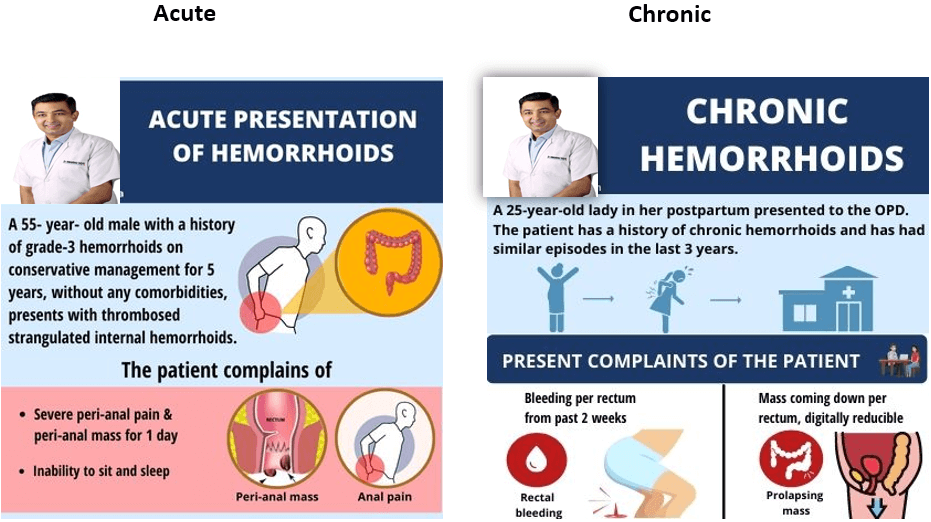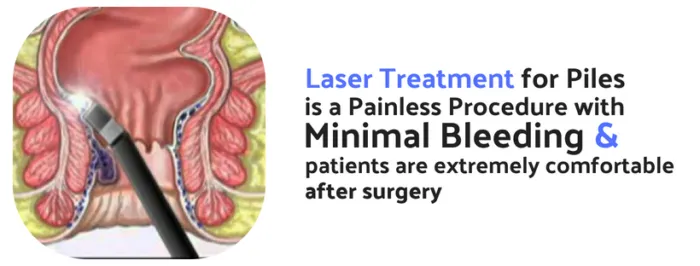The growing problem of piles: an overview
Understanding the need for effective treatment options

Piles, also known as hemorrhoids, have become a common concern for many
individuals. The discomfort and pain associated with this condition necessitate
the exploration of effective treatment options. In this article, we will delve
into the revolutionary laser treatment for piles to help you determine if it is
the right solution for you.
Understanding Piles
What are piles?
Piles, or hemorrhoids, are swollen blood vessels in the rectum or anus. This
condition can cause a range of uncomfortable symptoms, such as itching, pain,
and bleeding during bowel movements. It is essential to have a clear
understanding of piles to identify the most suitable treatment approach.
Causes and risk factors
Various factors contribute to the development of piles. Sedentary lifestyles
and lack of physical activity can increase the risk as they lead to poor blood
circulation in the rectal area. Additionally, dietary factors, such as
low-fiber intake and dehydration, can exacerbate the condition. Genetic
predisposition and advancing age are also significant risk factors for
developing piles.
Different types of piles
There are two primary types of piles: internal and external. Internal piles
occur inside the rectum, often causing bleeding during bowel movements. In
contrast, external piles form outside the anus and may cause discomfort and
itching. Understanding the type of piles one has is crucial for determining the
most suitable treatment approach.
Conventional Treatments for Piles
While traditional treatment methods exist, they may not always provide
effective relief. Here are some commonly used treatments:
A. Medications and creams
Over-the-counter medications and creams aim to alleviate pain and reduce
inflammation. However, they are often temporary solutions and may not address
the underlying cause of piles.
B. Rubber band ligation
This procedure involves tying off the base of the hemorrhoid with a rubber
band, cutting off its blood supply. Eventually, the hemorrhoid shrinks and
falls off. While effective, this method may cause mild discomfort and potential
complications.
C. Sclerotherapy
Sclerotherapy involves injecting a chemical solution into the hemorrhoid,
causing it to shrink. This treatment is typically used for smaller hemorrhoids
and may require multiple sessions.
D. Infrared coagulation (IRC)
Infrared coagulation utilizes infrared light to coagulate the blood vessels
within the hemorrhoid, leading to its shrinkage. This non-surgical method can
be an effective treatment option for smaller internal hemorrhoids.
E. Surgical procedures
For more severe cases, surgical procedures may be necessary.
Hemorrhoidectomy entails the surgical removal of hemorrhoids, while
hemorrhoidopexy focuses on stapling the hemorrhoids back into place.
Introduction to Laser Treatment
A. What is laser treatment?
Laser treatment for piles is a minimally invasive procedure that uses
focused laser energy to shrink and remove hemorrhoids. The laser technology
provides precision and targeted treatment for a more effective outcome.
B. Advantages of laser treatment for piles
Laser treatment offers several advantages over traditional surgical methods.
It minimizes tissue damage, reduces bleeding, and promotes faster recovery.
Additionally, laser treatment is associated with a lower risk of complications
and has a higher success rate.

How Laser Treatment Works
A. Procedure overview
During laser treatment, a specialized medical laser is used to precisely
target and coagulate the blood vessels within the hemorrhoids. This process
causes the hemorrhoids to shrink and eventually disappear.
B. Laser energy application and effects on piles
The laser energy is applied to the affected area, penetrating the hemorrhoid
and promoting the coagulation of blood vessels. As the blood supply to the
hemorrhoid is cut off, it shrinks and eventually gets reabsorbed by the body.
This targeted approach ensures minimal damage to surrounding tissues.
C. Comparison with traditional surgical methods
Compared to traditional surgical methods, laser treatment is less invasive
and reduces the risk of significant tissue trauma. It provides a more precise
treatment, leading to faster healing and minimal discomfort for the patient.
D. Minimally invasive nature and reduced recovery time
Due to its minimally invasive nature, laser treatment requires less recovery
time compared to conventional surgical procedures. Patients can typically
resume their daily activities sooner and experience minimal post-procedure
discomfort.
Benefits of Laser Treatment
A. High success rates and long-term effectiveness
Laser treatment has shown high success rates in both short-term and
long-term treatment outcomes. Patients often experience significant relief from
symptoms and have a lower chance of recurrence compared to other treatment
options.
B. Minimal pain and discomfort during and after the procedure
Laser treatment is renowned for its minimally invasive approach, resulting
in minimal pain and discomfort during the procedure. Patients typically
experience less post-procedure pain, allowing for a smoother recovery process.
C. Elimination of the need for hospitalization
Unlike traditional surgical procedures, laser treatment for piles is usually
performed on an outpatient basis. This eliminates the need for hospitalization,
making the treatment more convenient and cost-effective for the patient.
D. Lesser chances of recurrence compared to other treatments
Laser treatment not only provides immediate relief but also reduces the
chances of piles recurring in the future. Its targeted approach ensures that
the underlying causes of piles are addressed, resulting in long-term
effectiveness.
Safety and Risks Associated with Laser Treatment
A. Possible complications and side effects
While laser treatment for piles is generally safe, there are some potential
complications and side effects to be aware of. These include temporary
discomfort, mild bleeding, and rarely, infection. However, serious
complications are rare.
B. Suitable candidates for laser treatment
Laser treatment is suitable for individuals experiencing symptoms of piles
and seeking a minimally invasive treatment option. However, it is essential to
consult with a qualified healthcare provider to determine if laser treatment is
appropriate for your specific case.
C. Risks for pregnant women and individuals with certain medical conditions
Pregnant women and individuals with specific medical conditions, such as
bleeding disorders or immunodeficiency, may not be suitable candidates for
laser treatment. It is crucial to discuss your medical history and any existing
conditions with your healthcare provider before proceeding with any treatment.
Cost and Accessibility of Laser Treatment
A. Average costs of laser treatment
The cost of laser treatment for piles can vary depending on various factors,
including the location and the severity of the condition. On average, laser
treatment costs may range from a few hundred to a few thousand dollars.
B. Comparison with other treatment options
When comparing the cost of laser treatment to other treatment options, such
as surgical procedures, it is important to consider the long-term outcome and
potential savings from reduced recovery time and complications.
C. Insurance coverage considerations
Insurance coverage for laser treatment for piles may vary. It is advisable
to check with your insurance provider to determine if the procedure is covered
and to understand any associated out-of-pocket expenses.
Finding a Trusted Healthcare Provider
A. Researching and selecting a qualified specialist
When seeking laser treatment for piles, it is crucial to research and select
a qualified healthcare provider. Look for specialists who have experience in
performing laser treatments and have a good reputation in the field.
B. Seeking recommendations and referrals
Seeking recommendations and referrals from trusted sources, such as primary
care physicians or friends who have undergone similar treatments, can provide
valuable insights and help you find a trusted healthcare provider.
C. Verifying accreditations and certifications
Before undergoing laser treatment, verify the accreditations and
certifications of the healthcare provider. Ensure they are licensed and
recognized by reputable medical organizations to ensure your safety and the
success of the treatment.

Preparing for Laser Treatment
A. Initial consultation and evaluation
Before the laser treatment, an initial consultation and evaluation will be
conducted to assess your condition and determine if laser treatment is the most
suitable option for you. This is an opportunity to discuss any concerns or
questions you may have with your healthcare provider.
B. Necessary lifestyle modifications and dietary changes
Your healthcare provider may recommend necessary lifestyle modifications and
dietary changes to reduce symptoms and improve treatment outcomes. These may
include increasing dietary fiber intake, staying hydrated, and incorporating
regular exercise into your routine.
C. Preparing mentally and emotionally for the procedure
Preparing mentally and emotionally for the laser treatment is crucial for a
smooth experience. Engage in relaxation techniques, communicate openly with
your healthcare provider, and educate yourself about the procedure to alleviate
any anxiety or stress.

What to Expect During the Procedure
A. Step-by-step breakdown of the laser treatment process
During the laser treatment procedure, your healthcare provider will guide
you through the process step by step. They will ensure your comfort and
well-being throughout the treatment, explaining each stage to alleviate any
apprehension.
B. Anesthesia options and pain management
Depending on the specific case and the patient’s preference, anesthesia
options may vary. Your healthcare provider will discuss the available options
and determine the most appropriate pain management approach for you.
Recovery and Post-treatment Care
A. Post-procedure discomfort and pain management
After laser treatment, you may experience some post-procedure discomfort and
pain. Your healthcare provider will provide guidance on pain management
techniques and medications to alleviate any discomfort and promote a smooth
recovery.
B. Dietary recommendations and restrictions
Following laser treatment for piles, your healthcare provider may provide
specific dietary recommendations and restrictions to ensure optimal healing.
These may include avoiding spicy or greasy foods and increasing fiber-rich
foods in your diet to prevent constipation.
C. Follow-up appointments and monitoring progress
Regular follow-up appointments will be scheduled to monitor your progress
and ensure optimal healing. It is important to attend these appointments and
communicate any concerns or changes in your symptoms to your healthcare
provider.
Success Stories and Patient Experiences
A. Personal accounts of individuals who underwent laser treatment
Many individuals have experienced positive outcomes and improved quality of
life after undergoing laser treatment for piles. Personal accounts and
testimonials can offer valuable insights and reassurance for those considering
this treatment option.
B. Positive outcomes and improved quality of life
Laser treatment for piles has been shown to provide significant relief and
improve the quality of life for many individuals. Reduced pain, decreased
symptoms and increased comfort during daily activities are commonly reported
benefits.
Comparing Laser Treatment with Traditional Options
A. Effectiveness and long-term results
When comparing laser treatment with traditional options, laser treatment has
demonstrated comparable effectiveness and long-term results. It offers
additional benefits such as reduced pain and faster recovery times.
B. Cost and convenience
While laser treatment may involve a higher upfront cost compared to some
traditional treatments, its long-term cost-effectiveness, reduced recovery
time, and improved quality of life make it a convenient and valuable option for
many individuals.
C. Pain and recovery time
Compared to traditional surgical procedures, laser treatment significantly
reduces post-procedure pain and discomfort. This translates to a shorter
recovery time, allowing patients to resume their daily activities sooner.

Frequently Asked Questions (FAQs)
A. Can laser treatment completely cure piles?
Laser treatment aims to provide significant relief and long-term improvement
for individuals suffering from piles. While it can effectively address the
symptoms and underlying causes, complete eradication of piles may vary
depending on individual circumstances.
B. How long does the laser treatment procedure take?
The duration of the laser treatment procedure depends on the severity and
extent of the piles. On average, the procedure can be completed within 15
minutes to 30 minutes.
C. Are there any age restrictions for laser treatment?
Laser treatment for piles is generally suitable for individuals of various
age groups. However, it is essential to consult with a healthcare provider to
assess if laser treatment is appropriate for specific age-related
considerations.
D. Can laser treatment be performed on pregnant women?
Laser treatment for piles is typically not recommended for pregnant women.
It is important to discuss treatment options with a healthcare provider who can
provide appropriate guidance during pregnancy.
E. What is the success rate of laser treatment for piles?
Laser treatment has shown a high success rate in providing relief from
symptoms and improving the overall condition of piles. Individual success rates
may vary depending on the specific case and adherence to post-treatment care.
Summary
Revolutionary laser treatment for piles offers an effective and minimally
invasive solution for individuals seeking relief from the discomfort and pain
associated with this condition. With its high success rates, minimal pain, and
reduced recovery time, laser treatment provides a promising alternative to
traditional treatment options.
Concluding Remarks
When faced with the problem of piles, it is essential to seek medical advice
and explore all available treatment options. Consulting with a trusted
healthcare provider will help determine the most suitable course of action
based on individual circumstances. Remember, prioritizing your well-being and
seeking appropriate treatment can lead to improved quality of life.
Book Your Consultation Now!
Don’t let piles and fistula disrupt your life. Contact Dr. Himanshu Yadav’s clinic to schedule a consultation. Our team is committed to providing you with relief, comfort, and expert care. Take the first step towards better health today.
Call to Action (CTA): Ready to experience the benefits of laser treatment? Schedule your consultation now and embark on your journey to lasting well-being.
Conclusion
At Dr. Himanshu Yadav’s clinic, we are dedicated to providing comprehensive care for piles and fistula, including advanced laser treatments. Our combination of expertise, modern technology, and patient-centered approach sets us apart. Take control of your health today by reaching out to us and initiating your path towards lasting relief and improved quality of life.
Contact us on 8171944038, 8630729225 for any further enquiry
